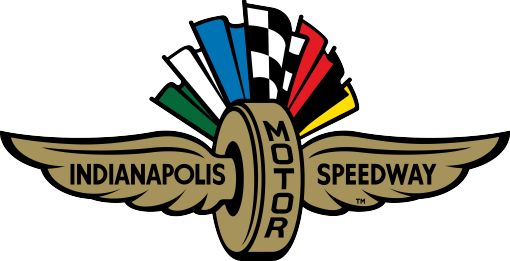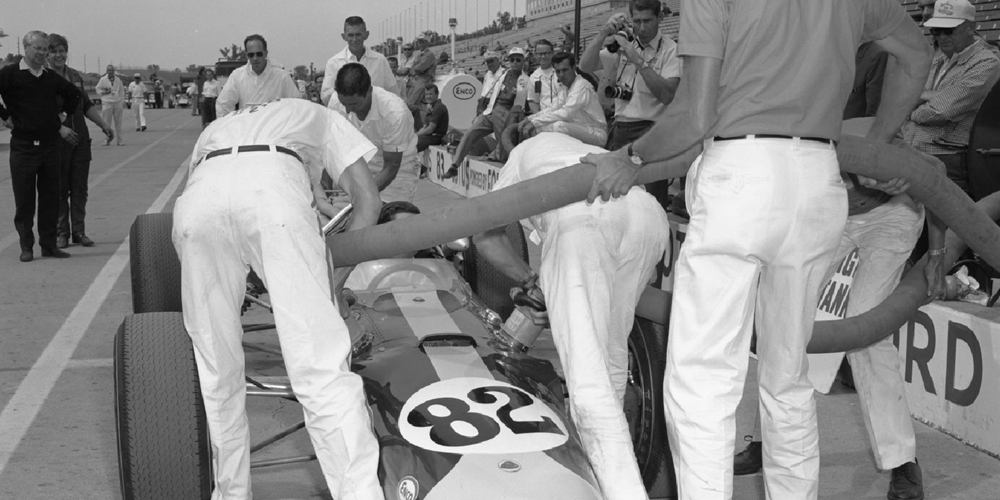The famed Wood Brothers Racing team had a historic connection to the Indianapolis Motor Speedway 29 years before NASCAR competed at the fabled Speedway in the inaugural Big Machine Vodka 400 at the Brickyard in 1994.
When Jim Clark drove the No. 82 Lotus powered by Ford to victory in the 1965 Indianapolis 500, it ushered in an era of innovation that continues to this day as Colin Chapman’s cigar-shaped creation as the first rear-engine car to win the world’s biggest race. While that car was innovation on the racetrack, there was also innovation on pit road from the most famous pit crew in NASCAR at that time – the Wood Brothers.
Four brothers – Glen, Leonard, Delano and Ray Lee – along with fellow crew members Kenny Martin and Jim Reed were responsible for the pit stops that day for not only the race-winning car driven by Clark but also Lotus teammate Bobby Johns.
Chapman and Clark had been serious contenders to win at Indianapolis in 1963 and 1964 but lost both years. They determined one way to get an advantage in 1965 was with superior pit stops, and that is when John Cowley of the Ford Motor Company contacted Glen Wood to bring the famed Wood Brothers of Stuart, Virginia, to Indianapolis.
They may have been from NASCAR, but the Woods made the most of their trip to the 500-Mile Race.
“I’m thinking, ‘Here we are going into a foreign team and how are they going to accept us?’” Leonard Wood said. “After they welcomed us being there, it worked fine. Then we took over the pit stops. They gave us a free hand to do what we needed to do on that end of it. We had already won the Daytona 500 in 1963, so what you do then is get your mind set on preparing the car for a pit stop. Indianapolis was a big event, with 300,000 people and all the people crowded around you, but we concentrated on doing our thing.”
The Wood Brothers were the first in NASCAR to determine that races could be won and lost in the pits. At that time, many pit stops could last 45 seconds to one minute while fuel was emptied into the race car and giant hammers were used to get the dial-pin off the old “knock-off’ wheels. But the Woods were able to develop a way to get an advantage with the gravity flow refueling system.
“We made the hoses to where they would both come equal length to the tank from the far side and inside and wouldn’t be buckled up,” Leonard Wood said. “We wanted the hose to run level downhill to the car and wanted a nice arc to both of them.
“One had to be a little longer than the other to reach the far side. The big deal was we already had experience in stock car racing by making fuel flow. They went from pressurized fuel systems in the years before, and 1965 was the first time they put it in under gravity. They figured everyone would be in the pits about a minute or so, and we had this giant venturi inside the tank.”
Of course, one of the USAC inspectors was skeptical of the fueling system.
“I remember the inspectors wanted to know why we had the outlets so far up on the tank,” Leonard Wood said. “If you make a round venturi it has to come off the bottom to make the circle perfect. We didn’t really worry about what he thought as long as it passed. He bet us $1,000 that we couldn’t pour 20 gallons a minute to come out of that tank.
“We weren’t interested in betting with him because we knew we would take his money. We went on and went through inspection and made a dry a run. We connected it and stopped it. We put 58 gallons in in 15 seconds. That was pretty awesome, really. We knew we would be under 20 seconds.
“The commentator Sam Hanks said: ‘You can bet they didn’t get it full with a green crew and all that. They’ll be coming back in.’ The race went on, and Jim Clark didn’t come back into the pits, so they sent a runner down to ask Chapman if he was running part gasoline and part alcohol so he didn’t have to put in as much. We were running pure alcohol. It was pretty neat the way it all came about.”
Clark, who led 190 of 200 laps, cruised to victory by just shy of two minutes to give Ford Racing its first win in the “500” and the first victory for a rear-engine car. Clark made all 500 miles that day on one set of Firestone Racing tires, which gave the winner superior wear, according to Leonard Wood.

“Treaded tires grip better when they are half-wore out than when they are brand new,” Wood said. “We did the same thing at Daytona with Tiny Lund in 1963. We measured the tread every time, and it had plenty of tread left and when the race was over.”
Clark made just two pit stops on his way to victory. Leonard was on the outside of Clark’s car with the filler hose with brothers Glen and Delano holding the hose to make sure there was no sag. Another brother, Ray Lee, checked the tires while Martin and Reed did other duties in the pit area, including help with scoring.
Glen’s son, Eddie, didn’t make the trip to Indianapolis because he had school that day back in Stuart, Virginia. But he proved to be just as innovative as his father and uncles by sneaking a transistor radio into his sixth-grade classroom.
“Remember this was 1965 so it wasn’t like an iPod; it was about the size of a pack of cigarettes,” Eddie Wood said of the radio. “I took that little thing you stick in your ear and ran that up my sleeve with the radio in my pocket. I wore a long-sleeve shirt and it was almost summertime, so it was hot. I remember everybody asking, ‘Why are you wearing a long-sleeve shirt?’ I was listening to the race during class.
“Fortunately, I didn’t get busted for it.”
By the time the race ended, young Eddie was on the school bus for the ride home and didn’t have to hide the radio any longer.
It would be 29 years before the Wood Brothers would perform their pit road magic at the Indianapolis, in the inaugural Brickyard 400 in 1994.
“It was special again because we pitted in the exact same spot as in 1965,” Leonard Wood said. “When we were there in 1965, we weren’t thinking about stock cars ever running at Indy.”
Of course, Eddie and Len did what any first-time visitor does at Indianapolis: Check out the “Yard of Bricks.”
“The first thing Len and I did when we went up there to test a year or two before the race, we walked straight to the Bricks and took each other’s picture with one of those $10 cameras you bought at the drug store,” Eddie said. “We went to the Museum and could have spent hours and days in there.”
Decades have passed since Memorial Day 1965, but the significance of that Indy 500 win remains today.
“We had to go to England (in 2011) to watch the car run again at the Goodwood Festival,” Leonard Wood said. “They restored it and wanted us to come over and watch it run. It brought back so many memories it was almost like we won the race again.”




